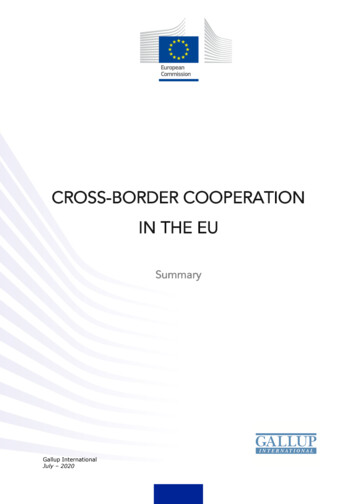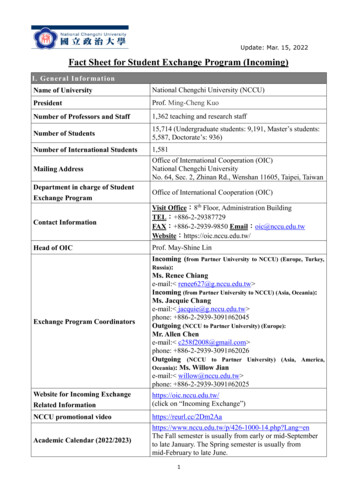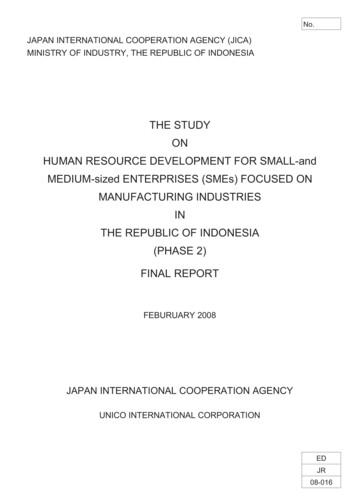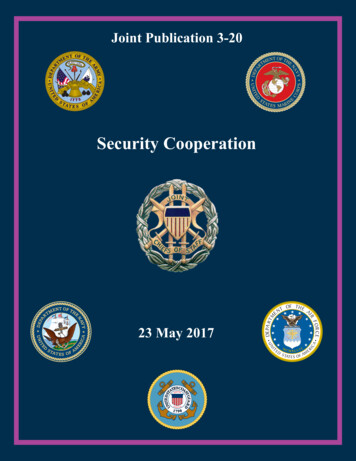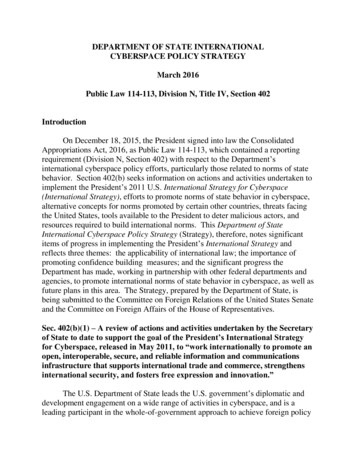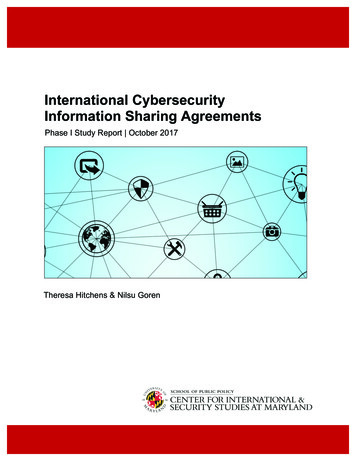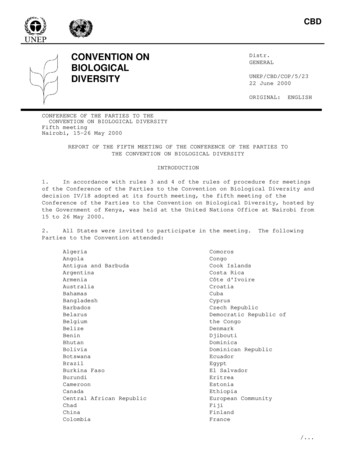
Transcription
Vienna International Centre, PO Box 500, 1400 Vienna, AustriaTel: ( 43-1) 26060-0, Fax: ( 43-1) 26060-5565, www.unodc.orgManual onInternationalCooperationin Criminal Mattersrelated to TerrorismFOR UNITED NATIONS USE ONLY*0856712*Printedin AustriaV.08-55977—July 2009—1,000
UNITED NATIONS OFFICE ON DRUGS AND CRIMEViennaManual on International Cooperation inCriminal Matters related to TerrorismUNITED NATIONSNew York, 2009
PrefaceThe Terrorism Prevention Branch of the United Nations Office on Drugs and Crime(UNODC), as mandated by the General Assembly, provides assistance to requestingcountries in the legal and related aspects of counter-terrorism, especially for thepurposes of ratifying and implementing the universal legal instruments againstterrorism and strengthening the capacity of national criminal justice systems toapply the provisions of those instruments in compliance with the principles of therule of law.In order to assist Member States in understanding the provisions contained in theuniversal instruments, drafting new legislation that complies with the requirementsof the universal instruments and enhancing international cooperation in criminalmatters relating to terrorism, UNODC has developed a number of technicalassistance tools. One of these tools is the present Manual on InternationalCooperation in Criminal Matters related to Terrorism, which has been developed toenable legal practitioners specialized in the fight against terrorism to efficiently andspeedily utilize international cooperation measures such as extradition and mutuallegal assistance, as well as to give them practical advice concerning the difficultiesand obstacles they may encounter. It can also serve as an educational tool to be usedin the training of legal practitioners in the fight against terrorism.iii
ContentsPagePreface. . . . . . . . . . . . . . . . . . . . . . . . . . . . . . . . . . . . . . . . . . . . . . . . . . . . . . . . . . . . .iiiIntroduction . . . . . . . . . . . . . . . . . . . . . . . . . . . . . . . . . . . . . . . . . . . . . . . . . . . . . . . .1Basic principles of international cooperation against terrorism . . . . . . . . . . .51.A.Criminalization of acts of terrorism . . . . . . . . . . . . . . . . . . . . . . . . . . . . . . . . . . . . .51.B.Legal basis for international cooperation against terrorism: the instruments forcooperation . . . . . . . . . . . . . . . . . . . . . . . . . . . . . . . . . . . . . . . . . . . . . . . . . . . . . . . . . 161.C.Obligations as regards international cooperation against terrorism . . . . . . . . . . . . 271.D.Rules for effective cooperation . . . . . . . . . . . . . . . . . . . . . . . . . . . . . . . . . . . . . . . . . 631.E.Competent national authorities . . . . . . . . . . . . . . . . . . . . . . . . . . . . . . . . . . . . . . . . . 67Module 1.Module 2.Mutual legal assistance in criminal matters . . . . . . . . . . . . . . . . . . . . . . . . . . . . 752.A.Goals of mutual legal assistance . . . . . . . . . . . . . . . . . . . . . . . . . . . . . . . . . . . . . . . . 752.B.Types of mutual legal assistance currently in use . . . . . . . . . . . . . . . . . . . . . . . . . . 772.C.Mutual legal assistance in the fight against the financing of terrorism:identification, detection, freezing, seizure and confiscation . . . . . . . . . . . . . . . . . . 952.D.Request for mutual legal assistance . . . . . . . . . . . . . . . . . . . . . . . . . . . . . . . . . . . . . 1132.E.Joint investigations . . . . . . . . . . . . . . . . . . . . . . . . . . . . . . . . . . . . . . . . . . . . . . . . . . . 142Module 3.Extradition . . . . . . . . . . . . . . . . . . . . . . . . . . . . . . . . . . . . . . . . . . . . . . . . . . . . . . . . 1433.A.Goals of extradition . . . . . . . . . . . . . . . . . . . . . . . . . . . . . . . . . . . . . . . . . . . . . . . . . . 1433.B.Provisional arrest for the purpose of extradition . . . . . . . . . . . . . . . . . . . . . . . . . . . 1443.C.Request for extradition . . . . . . . . . . . . . . . . . . . . . . . . . . . . . . . . . . . . . . . . . . . . . . . 1463.D.Applicable law: execution of the request in accordance with the law of therequested or requesting State . . . . . . . . . . . . . . . . . . . . . . . . . . . . . . . . . . . . . . . . . . . 1533.E.Outcome of the request . . . . . . . . . . . . . . . . . . . . . . . . . . . . . . . . . . . . . . . . . . . . . . . 1533.F. Cost of extradition . . . . . . . . . . . . . . . . . . . . . . . . . . . . . . . . . . . . . . . . . . . . . . . . . . . 1613.G.Module 4.Surrender of the person to be extradited . . . . . . . . . . . . . . . . . . . . . . . . . . . . . . . . . . 161Other types of cooperation . . . . . . . . . . . . . . . . . . . . . . . . . . . . . . . . . . . . . . . . . . . 1634.A.Other types of surrender . . . . . . . . . . . . . . . . . . . . . . . . . . . . . . . . . . . . . . . . . . . . . . 1634.B.Transfer of criminal proceedings: official request for the purpose ofprosecution . . . . . . . . . . . . . . . . . . . . . . . . . . . . . . . . . . . . . . . . . . . . . . . . . . . . . . . . . 1654.C.Transfer of detained persons already convicted . . . . . . . . . . . . . . . . . . . . . . . . . . . . 167AnnexesI.The United Nations Global Counter-Terrorism Strategy . . . . . . . . . . . . . . . . . . . . . 169v
II.Cooperation as regards exchange of information: relevant provisions of theuniversal instruments . . . . . . . . . . . . . . . . . . . . . . . . . . . . . . . . . . . . . . . . . . . . . . . . . 179III.Offences defined by the universal instruments . . . . . . . . . . . . . . . . . . . . . . . . . . . . 181IV.Indicative list of regional instruments relating to the prevention of terrorismand the suppression of the financing of terrorism . . . . . . . . . . . . . . . . . . . . . . . . . . 187V.Mutual legal assistance: relevant provisions of the universal instruments . . . . . . 191VI.Indicative list of multilateral conventions relating to mutual legal assistanceand extradition . . . . . . . . . . . . . . . . . . . . . . . . . . . . . . . . . . . . . . . . . . . . . . . . . . . . . . 193VII.Model declaration on cooperation in matters of extradition . . . . . . . . . . . . . . . . . . 199VIII.The right to information and communication from the time of arrest: relevantprovisions of the universal instruments . . . . . . . . . . . . . . . . . . . . . . . . . . . . . . . . . . 201IX.Notification of the arrest or detention of an alleged offender to all States and/orauthorities concerned: relevant provisions of the universal instruments . . . . . . . . 205X.List of national financial intelligence units . . . . . . . . . . . . . . . . . . . . . . . . . . . . . . . 211XI.Model of a hypothetical request to obtain written evidence . . . . . . . . . . . . . . . . . . 217XII.Model of a hypothetical request to obtain testimony . . . . . . . . . . . . . . . . . . . . . . . . 223XIII.Model of a hypothetical request for seizure . . . . . . . . . . . . . . . . . . . . . . . . . . . . . . . 229XIV.Model of a hypothetical request for the voluntary appearance of a person in therequesting State . . . . . . . . . . . . . . . . . . . . . . . . . . . . . . . . . . . . . . . . . . . . . . . . . . . . . 237XV.Model of a hypothetical request for interception or recording . . . . . . . . . . . . . . . . 243XVI.List of national central authorities in the fight against terrorism . . . . . . . . . . . . . . 249XVII.Indicative list of international instruments that mention the role of theInternational Criminal Police Organization in the transmission of information . . 253Index . . . . . . . . . . . . . . . . . . . . . . . . . . . . . . . . . . . . . . . . . . . . . . . . . . . . . . . . . . . . . . 259vi
IntroductionA.Context1.Terrorism: a threat to international peace and securitySince the adoption of the Convention for the Prevention and Punishment ofterrorism by the League of Nations in 1937, the fight against terrorism has beencontinuously on the agenda of the international community. Thus, since 1963 theinternational community has armed itself with an arsenal of 16 universal legalinstruments relating to the prevention and suppression of terrorist acts. Moreover,for more than a decade, the General Assembly of the United Nations, in particularon the initiative of its Sixth Committee, has adopted annual resolutions on measuresintended to fight international terrorism.As part of the plan of action of the United Nations Global Counter-TerrorismStrategy, Member States, resolved1 to cooperate fully in the fight against terrorism,in accordance with their obligations under international law, in order to find, denysafe haven and bring to justice, on the basis of the principle to extradite orprosecute, any person who supports, facilitates, participates or attempts toparticipate in the financing, planning, preparation or perpetration of terrorist acts orprovides safe havens; and to ensure the apprehension and prosecution or extraditionof perpetrators of terrorist acts, in accordance with the relevant provisions ofnational and international law, in particular human rights law, refugee law andinternational humanitarian law.The Security Council has also adopted several resolutions regarding the fightagainst terrorism. Resolution 1373 (2001),2 of 28 September 2001, adoptedfollowing the attacks of 11 September 2001, is of particular importance because ofits effective range of action. Importantly, the resolution was adopted by the Councilunder Chapter VII of the Charter of the United Nations,3 which means that terrorismmust be regarded as a threat to international peace and security.In the resolution, the Council called on States to work together urgently toprevent and suppress terrorist acts, including through increased cooperation and fullimplementation of the relevant international conventions relating to terrorism, andrecognized the need for States to complement international cooperation by takingadditional measures to prevent and suppress, in their territories through all lawfulmeans, the financing and preparation of any acts of terrorism.Before the adoption of resolution 1373 (2001), the number and thecomplementarity of conventions, protocols and resolutions of the United Nationsagainst terrorism already constituted a structure that offered an effective legalframework for international legal cooperation in criminal matters. However, in thatresolution, the Security Council called upon all States to become parties as soon aspossible to the relevant international conventions and protocols relating to terrorism123General Assembly resolution 60/288, annex, section II, paragraphs 2 and 3 (see annex I for thetext of the resolution).See PDF/N0155743.pdf?OpenElement.See http://www.un.org/aboutun/charter/.1
Manual on International Cooperation in Criminal Matters related to Terrorism(paragraph 3 (d)), giving the existing texts a much greater impact than they had hadbefore.In General Assembly resolution 60/288, Member States resolved to implementall General Assembly resolutions on measures to eliminate international terrorism.It is in this context that international cooperation in criminal matters related toterrorism is of major importance in the realization of the goal of preventing andsuppressing such offences. However, mechanisms for international cooperation areof no use without their effective use by Member States and their counter-terrorismpractitioners.2.Strengthening international cooperation in criminal mattersAgainst the backdrop of globalization and the development of internationalterrorism, therefore, it is necessary to strengthen the means to punish offencescommitted in that context on an international scale. It is often difficult to startinvestigations and prosecutions against those suspected of participating in terroristactivities. It is even more difficult to try to institute proceedings when the suspect,the victim, the principal evidence, the principal witnesses, the principal experts orthe proceeds of the crime do not come under the authority of the country concerned.Whereas all forms of transnational criminality, including terrorism, have thrivedwith globalization, the national mechanisms for cooperation between States stilllack cohesion and are often ineffective. Yet international cooperation is essential tocriminal justice practitioners faced with new forms of transnational criminality andterrorism. It is indeed unrealistic today to confine all criminal investigations orprosecutions related to terrorism within national borders. This is even more so ascriminals profit from the advantages obtained for the protection of citizens withinthe framework of state sovereignty.The international community has developed a series of mechanisms forinternational cooperation in criminal matters concerned in particular withextradition, mutual legal assistance, the transfer of criminal proceedings, thetransfer of convicted persons, recognition of decisions of foreign criminaljurisdictions, the freezing or seizure of assets, and cooperation between lawenforcement agencies. Those mechanisms relate to all types of criminality –international, transnational or national – including terrorism.4On the other hand, other types of cooperation may be specific to the fightagainst terrorism, in particular concerning cooperation in the fight against thefinancing of terrorism.B.Objective of the ManualThe objective of the present Manual on International Cooperation in CriminalMatters related to Terrorism is to enable legal practitioners specialized in the fightagainst terrorism to act more effectively and more rapidly, that is, to provide themwith immediate answers concerning the tools they can use to fight against this eviland the relevant types of cooperation, as well as to give them practical advice42A/CONF.203/5, paragraph 56.
Introductionconcerning the difficulties and obstacles they may encounter. It is also intended foruse as a teaching aid in the training of legal practitioners in the fight againstterrorism.C.Function of the ManualThe Manual should provide appropriate answers to questions from criminal justiceprofessionals arising in the application of the universal instruments againstterrorism and, more generally, in the context of implementation of Security Councilresolution 1373 (2001) and General Assembly resolution 60/288, as well as otherrelevant resolutions.5 In fact, as far as international cooperation in criminal mattersis concerned, States enter into bilateral and regional treaties, ratify internationalconventions or act by virtue of reciprocity. Given the universality of the terroristthreat, it is no longer judicious to confront it mainly through bilateralism or evenregionalism, as many terrorist activities now involve illegal activities in two or morecountries that may not have entered into bilateral or regional cooperationagreements. The universal instruments, which by their very nature have a broadgeographical scope, make it possible for all countries to cooperate, to benefit from abroadened scope of cooperation, to restrict and even completely eliminate theconditions and grounds for refusal to cooperate whenever compatible with bindinghuman rights standards, and to speed up proceedings.Furthermore, this same concept of States working together should prevail withregard to the suppression of terrorism, which is made easier by the universalinstruments. Criminals seek to exploit the differences between legal systems, takeadvantage of the lack of coordination between government services in differentcountries and exploit the concern for sovereignty of most States and, often, the factthat certain countries are unable to overcome their differences in order to worktogether. While taking into account different legal traditions, it is advisablenonetheless to provide the means for effective cooperation.D.Structure of the ManualThe Manual is divided into four modules. The first module presents the basicprinciples of international cooperation against terrorism. These are rules that applyto all forms of cooperation required for prevention and for criminal prosecution. Thesecond is devoted to mutual legal assistance, while the third relates to extradition.The fourth module concerns other types of cooperation.Annexes can be found at the end of the Manual and the index facilitatessubject searches.5Security Council resolutions 1267 (1999), 1452 (2002), 1456 (2003), 1526 (2004), 1535 (2004),1540 (2004), 1566 (2004), 1617 (2005), 1624 (2005) and 1730 (2006).3
Module 1Basic principles of international cooperation againstterrorismObjectives1.A. To determine the legal basis used to criminalize acts of terrorism and,consequently, to identify the offences and criminal statutes related to requestsfor international cooperation in criminal matters.1.B. To determine common legal basis for all types of international cooperationagainst terrorism.1.C. To define obligations as regards international cooperation against terrorism.1.D. To lay down useful rules for effective cooperation.1.E. To identifying the competent national authorities that will be called upon toparticipate in international cooperation in criminal matters.1.A.Criminalization of acts of terrorismActs of terrorism are defined in the sectoral universal conventions andprotocols related to the fight against terrorism.Being legally binding, the universal instruments constitute a universal basisfor international cooperation in criminal matters since they cover almost all theoffences and mechanisms required for the fight against terrorism at the internationallevel. This arsenal of legal instruments is supplemented by Security Councilresolution 1373 (2001) of 28 September 2001, which constitutes a particularlysignificant mechanism of coordination for international cooperation in criminalmatters. Other instruments, regional or national, are used to criminalize acts ofterrorism. The following therefore constitute the legal basis for the criminalization ofacts of terrorism:(a)Relevant resolutions of the Security Council;(b)Universal instruments;(c)Regional instruments;(d)National legislation.Choice of legal basis. In order to determine which of all the legal instrumentsis appropriate in a particular case, practitioners should take into account:(a)The hierarchy of international standards;(b)The scope of the instruments;(c) The legal tradition of States regarding the application ofinternational treaties and agreements in domestic law.5
Manual on International Cooperation in Criminal Matters related to Terrorism(a)Hierarchy of international standards: primacy of the resolutions of the SecurityCouncilSecurity Council resolutions relating to the fight against terrorism and thenegotiated universal instruments truly complement one another. Thus, theimplementation of resolutions, the provisions of which are not always precise,requires the ratification and application of the universal conventions and protocols,which are very precise texts. The binding resolutions of the Security Council are tobe implemented in the light of the negotiated universal instruments.In fact, as explained below, the resolutions of the Security Council adoptedunder Chapter VII of the Charter of the United Nations: must be applied by allMember States; take precedence over any other international obligation; and,finally, are binding. Mandatory application by States¾¾Article 24 of the Charter of the United NationsoIn order to ensure prompt and effective action by the UnitedNations, its Members confer on the Security Council primaryresponsibility for the maintenance of international peace andsecurity, and agree that in carrying out its duties under thisresponsibility the Security Council acts on their behalf.oIn discharging these duties the Security Council shall act inaccordance with the Purposes and Principles of the United Nations.The specific powers granted to the Security Council for thedischarge of these duties are laid down in Chapters VI, VII, VIII,and XII.Article 25 of the Charter of the United NationsoThe Members of the United Nations agree to accept and carry outthe decisions of the Security Council in accordance with the presentCharter.Relevant Security Council resolutions are thus binding in accordance with theCharter of the United Nations, adopted as an international convention. Theresolutions clearly state that all means to combat terrorism must be taken inconformity with the Charter and with international law.6 Primacy over any other international obligation. Under Article 103 of theCharter of the United Nations, in the event of a conflict between theobligations of the Members of the United Nations under the Charter and theirobligations under any other international agreement, their obligations under theCharter shall prevail (see the International Court of Justice Order of 14 April1992, Lockerbie case, concerning Security Council resolution 748 (1992).)7676Security Council resolution 1373 (2001) refers to international standards of human rights andresolutions 1456 (2003), 1535 (2004), 1566 (2004) and 1624 (2005) refer to international humanrights, refugee and humanitarian law.“In accordance with Article 103 of the Charter, the obligations of the Parties in that respect
Module 1. Basic principles Binding power¾Based on Chapter VII of the Charter8¾Paragraphs 1 and 2 of Security Council resolution 1373 (2001): theCouncil “decides”9¾To put the resolution into effect, the Security Council may take bindingmeasures that it sees fit (Articles 41 and 42 of the Charter)108910prevail over their obligations under any other international agreement” (see paragraph 42 ofQuestions of Interpretation and Application of the 1971 Montreal Convention arising from theAerial Incident at Lockerbie (Libyan Arab Jamahiriya v. United States of America), ProvisionalMeasures, Order of 14 April 1992, I.C.J. Reports 1992, p. 114). (available at e.htm)). (See also the two judgements of the Court of FirstInstance of the European Communities case T-306/01, judgement of 21 September 2005 (AhmedAli Yusuf and Al Barakaat International Foundation v. Council of the European Union andCommission of the European Communities), and case T-315/01, judgement of 21 September2005 (Yassin Abdullah Kadi v. Council of the European Union and Commission of the EuropeanCommunities): “From the standpoint of international law, the obligations of the Member Statesof the United Nations clearly prevail over every other e.htm).Chapter VII. Action with respect to threats to the peace, breaches of the peace, and acts ofaggression:“Article 39. The Security Council shall determine the existence of any threat to the peace,breach of the peace, or act of aggression and shall make recommendations, or decide whatmeasures shall be taken in accordance with Articles 41 and 42, to maintain or restoreinternational peace and security.“Article 40. In order to prevent an aggravation of the situation, the Security Council may,before making the recommendations or deciding upon the measures provided for inArticle 39, call upon the parties concerned to comply with such provisional measures as itdeems necessary or desirable. Such provisional measures shall be without prejudice to therights, claims, or position of the parties concerned. The Security Council shall duly takeaccount of failure to comply with such provisional measures.”The exact nature of the obligations set forth in the Security Council resolutions depends on thewording used. It is generally agreed that Council decisions are obligatory (where the Council“decides”), whereas its recommendations (where the Council “calls on” Member States) do nothave the same legal value. Of the three paragraphs of resolution 1373 (2001) addressed toStates, the first two are expressed as binding decisions, while the third is expressed as arecommendation.“Article 41. The Security Council may decide what measures not involving the use ofarmed force are to be employed to give effect to its decisions, and it may call upon theMembers of the United Nations to apply such measures. These may include complete orpartial interruption of economic relations and of rail, sea, air, postal, telegraphic, radio,and other means of communication, and the severance of diplomatic relations.“Article 42. Should the Security Council consider that measures provided for in Article 41would be inadequate or have proved to be inadequate, it may take such action by air, sea,or land forces as may be necessary to maintain or restore international peace and security.Such action may include demonstrations, blockade, and other operations by air, sea, orland forces of Members of the United Nations.”7
Manual on International Cooperation in Criminal Matters related to Terrorism(b)Scope of the instrumentsBy their nature, the universal instruments have a broader geographical scope thanregional or national instruments as regards offences and cooperation in criminalmatters. In addition to the fact that the latter have a limited geographical scope ofapplication, it is important that they not contravene the universal instruments,11which cover most types of terrorism and offer a legal regime specific to the fightagainst terrorism as a threat to peace. Terrorism is an offence that affects the globalcommunity as a whole. The threat being international, the answer should thereforebe universal. Consequently, Security Council resolution 1373 (2001) has a generalrange of action, not limited in time or space.(c)Legal tradition of States regarding the application of international treaties andagreements in domestic lawThere are two principal ways in which to apply international treaties in domesticlaw. The process is determined by the system governing the relation betweeninternational law and the law adopted by the State, depending on whether the Statehas a monist or a dualist system:(i) Monist systems.12 In a monist system, international and national law areof a unified nature, the two sources being treated as belonging to the samelegal family. In this approach, when a State ratifies a treaty, the treaty has thesame authority as its national law, without the need for recourse to specificlegislative provisions in order to put it into effect. Thus, once a treaty has beensigned and ratified, a State with a monist system is bound by the text of theinstrument. Accordingly, national jurisdictions and other public organismsrefer directly to the provisions of the treaty itself as a source of law.It should be noted that there are also different approaches within monistsystems, namely:a.Systems in which only certain treaties are considered as directlyapplicable in domestic law and where provisions of treaties share the samehierarchical level as domestic laws, in compliance with the principle that themost recent law takes precedence;13b.Systems in which the treaties are superior to legislative acts, but theirstatus remains inferior to constitutional provisions.14However, even in a monist legal system, the existence of national legislation isrequired to establish sanctions;111213148For example, under the universal instruments, a request for cooperation may not be refused onthe ground of political motivation of the act.For example, Benin, Bolivia, Cyprus, Switzerland and the United States of America are civil lawcountries and follow the monist system.For example, Albania (article 122 of its Constitution), Germany (article 25 of its Constitution),Romania (article 11 of its Constitution) and Turkey (article 90 of its Constitution).For example, Central African Republic (article 69 of its Constitution), France (article 55 of itsConstitution), Greece (article 28 of its Constitution), Haiti (article 276-2 of its Constitution),Lithuania (article 105 of its Constitution) and Netherlands (articles 91 and 95 of itsConstitution).
Module 1. Basic principles(ii) Dualist system.15 Dualist systems are subject to one constraint:international law and domestic law exist separately and most often functionindependently of one another. In contrast to monist systems, when a State witha dualist system binds itself to an international treaty, the treaty does notautomatically have the authority of national law. Accordingly, nationallegislative action is required for incorporation in order to give the treaty itsfull effect.16However, once a State has been bound by a treaty, through its signature andratification, it is then bound by the international legal obligations: 17 it must complyor it will risk violating its international obligations.18 It is thus the responsibility ofthe legislative power to ensure that the domestic law applies the international law,rather than contravening it.Furthermore, before an act is passed incorporating the treaty into national law,national jurisdictions are not strictly bound by the provisions of the treaty. Inpractice, however, such sources of law are considered very persuasive. Accordingly,jurisprudence of the high courts illustrates that judges use international law as a15161718It should be noted that most Commonwealth countries observe the dualist system; for example:Kenya and Malaysia. Fifty-three countries make up the Commonwealth: Antigua and Barbuda,Australia, Bahamas, Bangladesh, Barbados, Belize, Botswana, Brunei Darussalam, Cameroon,Canada, Cyprus, Dominica, Fiji, Gambia, Ghana, Grenada, Guyana, India, Jamaica, Kenya,Kiribati, Lesotho, Malawi, Malaysia, Maldives, Malta, Mauritius, Mozambique, Namibia,Nauru, New Zealand, Nigeria, Pakistan, Papua New Guinea, Saint Kitts and Nevis, Saint Lucia,Saint Vincent and the Grenadines, Samoa, Seychelles, Sierra Leone, Singapore, SolomonIslands, South Africa, Sri Lanka, Swaziland, Tonga, Trinidad and Tobago, Tuvalu, Uganda,United Kingdom of Great Britain and Northern Ireland,
3.F. Cost of extradition . The right to information and communication from the time of arrest: relevant provisions of the universal instruments. 201 IX. Notification of the arrest or detention of an alleged offender to all States and/or . Matters related to Terrorism is to enable legal practitioners specialized in the fight


